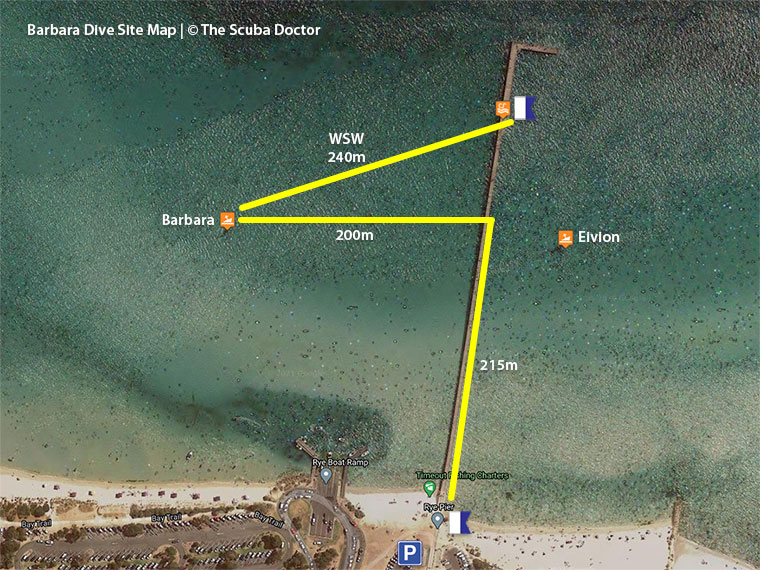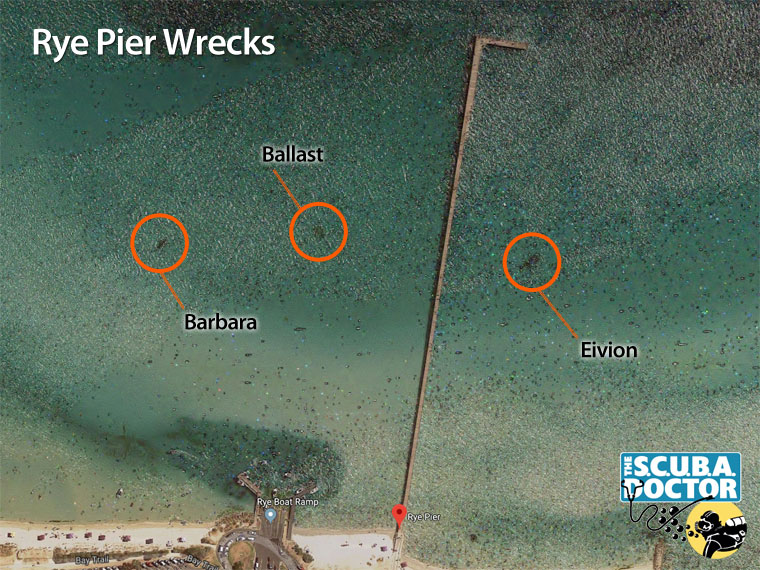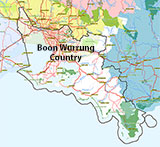Barbara
![]() Wreck Dive |
Wreck Dive | ![]() Shore access
Shore access
![]()
![]()
![]()
![]()
Wooden Schooner | Max Depth: 4 m (13 ft)
Level: Open Water and beyond.
The Barbara was built in Tasmania in 1841, used as a lime trader in Port Phillip and sank in 1852 at Rye in Port Phillip. The shipwreck is a rare example of early Australian shipbuilding.
The location of the Barbara shipwreck was hidden for nearly 170 years until its discovery in 2018 near Rye Pier by wreck hunter Peter Taylor, who had been researching lost local lime trade vessels. Barbara was one of several lime trading ships lost on the Mornington Peninsula.
Diving and Snorkelling the Barbara Shipwreck
The remains of the Barbara shipwreck consist of some frames and planking and a small pile of green rounded ballast stones.
As a shore dive, the safest option is to head WSW on a bearing of 248° for about 240 metres from the divers landing on Rye Pier.
Another option is to head out from the shore under Rye Pier for about 215 metres and then head west for about 200 metres to the Barbara.
Both options will test your compass navigation skills. Gets easy if you have a dive computer with GPS, or a suitable GPS unit.
Location: Point Nepean Road, Rye, Victoria 3941
MELWAY Ref: Page 168 F4
Safety: The Barbara lies in a high traffic boating area. For your own safety, you must use a surface dive float with a dive flag.
Entry/Exit: Entry can either be from the lower landing near the end of Rye Pier, or straight off the beach. Straight off the beach means crossing a large sandbank.
Ideal Conditions: Offshore southerly winds and high tide. Not diveable in strong northerly winds. Though high tide is ideal to get more depth, you are able to dive this site on any tide. See WillyWeather (Rye Pier) as a guide for the tide times and the height of the tide.
Barbara Shipwreck Research
Heritage Victoria partnered with Flinders University's annual maritime archaeology field school and the community-based Maritime Archaeology Association of Victoria to investigate the Barbara in early 2020.
The Flinders University Maritime Archaeology Program runs a field school every year to train our students and short-course participants in the practical skill sets of underwater archaeology. This video highlights the 2020 Field School in the Mornington Peninsula, Victoria, and scientific diving for archaeology.
Barbara Shipwreck History — Built in 1841
The Barbara was a wooden schooner of 16 l-ton (16 t), built in 1841, at Exeter River, Tasmania. Used as a lime trader, the Barbara was 16 gross tons with dimensions of 39.3 ft (12 m) length, 10.8 ft (3.29 m) breadth and 5.5 ft (1.68 m) depth. The deep hull, solid design and sophistication of the build make the Barbara very interesting. It has an excessively thick hull, with the planking being two layers of jarrah from Western Australia, the frame was made of tea tree, and there was eucalypti from New South Wales and Victoria.
The ship's builder was Joseph Hind, a farmer from the Tamar Valley in Northern Tasmania who came from England to Van Diemen's Land in 1828 with his wife Barbara. Records of shipping movements show Barbara transported livestock and wool up the rivers, before being registered in Victoria from 1846. Ships weren't built in Australia until 1820, which makes the Barbara one of Australia's earliest vessels.
Barbara Sinking — 6 August 1852
The Barbara, under the command of Captain Josheph Theobold, dragged anchors in a strong northerly force 10 gale and was forced ashore on 6 August 1852 in the shallows at White Cliffs, Rye, in Port Phillip. There was no reported loss of life, and the Barbara became a total wreck.
See also Heritage Council Victoria: Barbara, and
Australian National Shipwreck Database: Barbara..
The Barbara is listed with Heritage Victoria as a ship of historical significance.
Rye Pier Shipwrecks
Eivion: The wreck of the Eivion lies to the east of Rye Pier, in about 2 metres of water. It can be spotted from up on the pier (about halfway) as a dark patch. It is often home to many nudibranchs and rays. You can find shrimp and a variety of small fish. Something nice to change things up or to head to on a second dive.
There are also two dark patches on the eastern side of Rye Pier clearly visible on Google Earth. Both sites lie on a clear sandy seabed with a maximum depth of 3 metres. Both sites are accessible via the shore or the pier as well as by boat. Both sites are heavily overgrown with weed, making it difficult to distinguish features.
The patch closest to the west side of Rye Pier is at
Latitude: 38° 22.010′ S (38.3668332° S / 38° 22′ 0.6″ S)
Longitude: 144° 49.293′ E (144.82155° E / 144° 49′ 17.58″ E)
.
146 m, bearing 237°, WSW
This appears to be a mound of basalt rocks (not dressed) and is typical of a ballast mound from a ship.
Barbara: The second patch, further to the west, is the shipwreck remains of the wooden schooner Barbara. The remains consist of some frames and planking and a small pile of green rounded ballast stones. From the size and shape of the frames.
Caution: Care needs to be taken if you plan to visit the sites of these shipwrecks, especially those west of Rye Pier, offshore from the Rye Boat Ramp. These are high traffic boating areas. For your own safety, you must use a surface dive float and dive flag.
The sand in this part of Port Phillip is highly mobile and there may be more of the wreck underneath the seabed.
Historical accounts of shipwrecks at Rye inform us that four wrecks have occurred in the vicinity of Rye Pier.
- Barbara: schooner, built at Exeter River Tamar, Tasmania, 1841, 39.3’ x 10.8’ x 5.5’ (feet), 16 tons. Owned by Capt. G. W. Cole. Totally wrecked at White Cliffs (Rye), 6 August, 1852.
- Opossum, cutter, carvel built, Macquarie Harbour, Tasmania, 1827, 36.2’ x 10.8’ x 6.4’ (feet), 19 tons. Totally wrecked White Cliffs ca 1853.
- Adieu: ketch, built at Gravelly Beach, Tasmania, 1877, 38.9’ x 13.8’ x 5.5’ (feet), 15 tons, owned by David Inverarity, totally wrecked below Rye, 3 September, 1882.
- Eivion: ketch, built Williamstown, 1886, 27 tons, 65.8’ x 16.2’ x 4.2’ (feet), previously owned by Benjamin Stenniken. Totally wrecked in the vicinity of Rye Pier 4–5 December, 1921.
Traditional Owners — This dive site is in the traditional Country of the Boon Wurrung / Bunurong people of the Kulin Nation. This truly ancient Country includes parts of Port Phillip, from the Werribee River in the north-west, down to Wilson's Promontory in the south-east, including the Mornington Peninsula, French Island and Phillip Island, plus Western Port. We wish to acknowledge the Boon Wurrung as Traditional Owners. We pay respect to their Ancestors and their Elders, past, present and emerging. We acknowledge Bunjil the Creator Spirit of this beautiful land, who travels as an eagle, and Waarn, who protects the waterways and travels as a crow, and thank them for continuing to watch over this Country today and beyond.
Barbara Location Map
Latitude: 38° 22.012′ S (38.366867° S / 38° 22′ 0.72″ S)
Longitude: 144° 49.221′ E (144.82035° E / 144° 49′ 13.26″ E)
Datum: WGS84 |
Google Map
| Get directions
Added: 2021-02-06 00:49:34 GMT, Last updated: 2022-04-29 17:07:40 GMT
Source: Google Earth
Nearest Neighbour: Rye Pier, 242 m, bearing 70°, ENE
Wooden Schooner.
Built: Exeter River, Tasmania 1841.
Sunk: 6 August 1852.
Rye, Mornington Peninsula, Port Phillip.
Depth: 4 m.
[ Top ]
DISCLAIMER: No claim is made by The Scuba Doctor as to the accuracy of the dive site coordinates listed here. Should anyone decide to use these GPS marks to locate and dive on a site, they do so entirely at their own risk. Always verify against other sources.
The marks come from numerous sources including commercial operators, independent dive clubs, reference works, and active divers. Some are known to be accurate, while others may not be. Some GPS marks may even have come from maps using the AGD66 datum, and thus may need be converted to the WGS84 datum. To distinguish between the possible accuracy of the dive site marks, we've tried to give each mark a source of GPS, Google Earth, or unknown.





